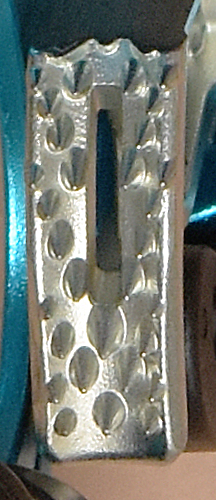 Technical Details
Technical Details
I acquired a right-hand S.E.Peak SA–203R from Amazon.com in 2023.
The S.E.Peak SA-203R is 195 mm. tall, 92 mm. wide, 29 mm. thick, and weighs 184 g. The rope channel is 15 mm. wide. The cam axle is centered 42 mm. from the inside of the rope channel. The cam radius, measured from the axle axis, increases from 37 to 54 mm. over an angle of 38°, giving a 30° cam angle. The tooth pattern is (3.4)(1S1)^2(2S2)(1S1)^3(2.3.2.2.3).
The front of the ascender is printed with a hollow up-pointing arrow containing "UP" and "SA-203R." The rear is printed with the S.E.Peak logo with "S.E.Peak," "EN 567:2013," "Ø8-13mm," and "100g."
These ascenders have the same design, with differences only in the color of their anodizing and in their markings:
These are well-made ascenders and
perform much like the Petzl Ascension.
All sharp edges have been removed. The attachment points are simple
holes in the shell. They have sharp edges that should be rounded with a file; even so, I would consider
their small radius too sharp for directly attaching sling ropes.
They are probably acceptable for webbing, but considering
the proximity of the attachment points to the main rope, I would
recommend using a small maillon for most attachments in order
to reduce the risk of sling abrasion.
The upper rope attachment
hole is located very close to the main rope. A carabiner through
the upper attachment hole will probably drag on the main line.
Note that such a carabiner will prevent putting the ascender on
or off rope, so one's climbing system must be designed accordingly.
The handgrips are almost large enough to be comfortable for my large hands, provided I don't wear gloves. In any case, I
don't climb by gripping ascenders at their handle. I think it is better to simply grasp the ascender
from above and lift the ascender in the traditional manner (unless, of course, you are one of those who prefers to climb Frog).
The cam is very well made. The cam stop is placed in a position
where it will touch the cam if the ascender is off rope.
This keeps the face of the cam away from the inner surface of the rope groove, a nice but unnecessary feature. I don't see much need for cam stops, most
active cavers don't weight enough to bend their ascenders to failure
by cam pull-through, and there is no need to shock load one's
ascenders.
The safety has a ribbed thumb surface. One-handed operation is smooth and comfortable.
These ascenders have the same pit lip disadvantage as the
Clog and other stamped frame ascenders,
although the reinforcing will help prevent bending.
The lower attachment hole is large enough to accommodate two normal carabiners, but I don't think carabiners are the best way to attach caving slings to ascenders, as there is too much chance of having the ascender slide down and load the carabiner gate.

For far more content, use a larger monitor and a full-width window.
Hundreds of cell phone users complained and asked me to for a simpler, mobile friendly site. In particular, they wanted me to limit each page to a small number of pictures and minimize my use of text. This new site provides what they asked for.

